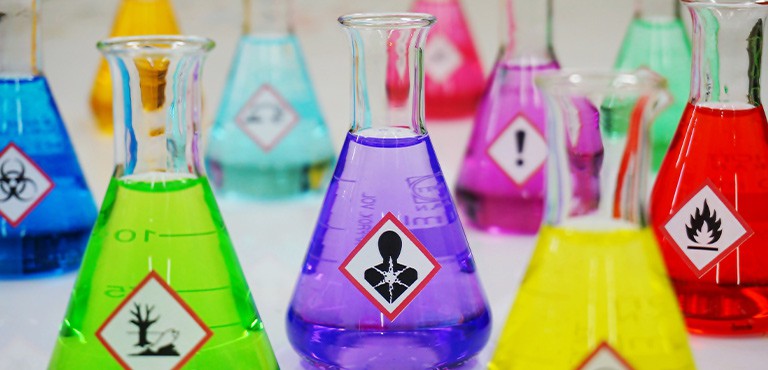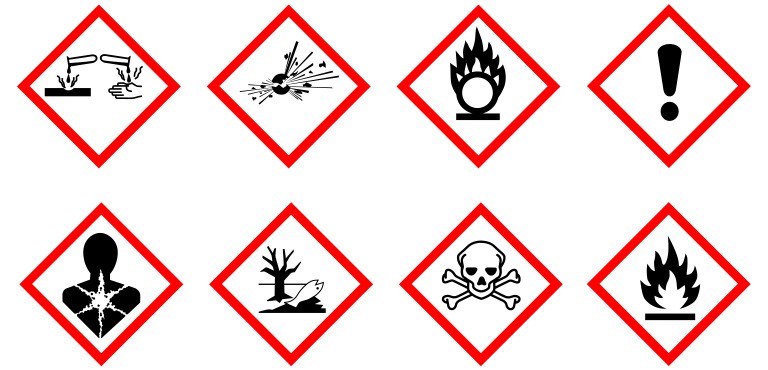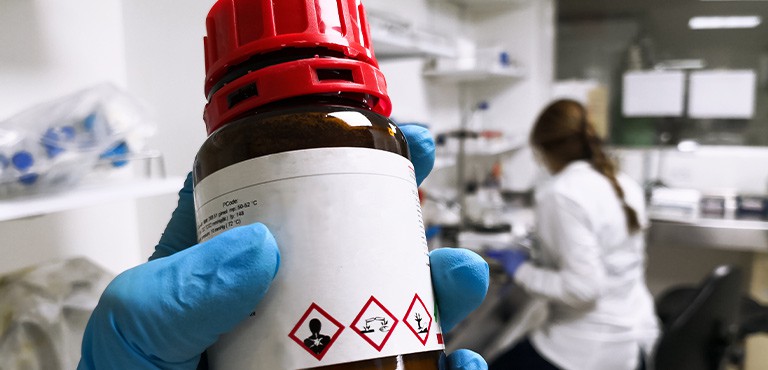You're Responsible for Ensuring That the Labeling of Your Chemical Products is Correct
Many chemical products sold today have dangerous properties that the product user needs to know. Because of this, you who place chemical products on the market must inform product users about the dangers and how they can best protect themselves and the environment.
Regardless of whether you’re a manufacturer, importer, downstream user, or distributor, you’re responsible for ensuring that the labeling of your chemical products is correct. But to know which information must be on the chemical label and how the label itself should be designed can be difficult.
To help you start off right, we offer you help from our consultants who have long experience working with safety data sheets and labeling chemical products. We can help you review, translate, and compile new safety data sheets and review the labeling of your chemical products.
You’re always welcome to book a meeting with one of our experienced EHS consultants here at Intersolia.
Why Do We Need to Label Our Chemical Products?
Central to the work of managing chemical products is to have the correct documentation, information, and instructions to ensure that the chemicals are managed safely. Both the Environmental Code (1998: 808) and REACH (EU common legislation regarding chemicals) require that operators must have safety data sheets that comply with applicable laws and regulations for all chemical products used in their business.
Therefore, if you place products containing chemicals on the market, you must inform product users about the risks and how they can protect themselves and the environment. This information needs to be provided by the label on the packaging, how this label is to be designed is regulated by the CLP Regulation (EC) 1272/2008. All suppliers, manufacturers, importers, distributors, and retailers are responsible for ensuring that the chemical product labeling is correct both in terms of content and appearance.
Which Chemical Products Need Labeling?
All packaging, containers, and pipelines that contain chemical substances must be marked with the correct information. The product user must be able to identify both the contents and the hazards associated with the use and storage of the chemical product.

What Should Your Label Include?
The information on the label is there to protect the product user. There must be clearly shown what the product contains, what risks there are, and how users should protect themselves. The label information should also include who the user should contact in the event of an accident. Because of this, the person working with the chemical product must always be able to read and interpret what the label says, which is regulated by the CLP regulation.
Labeling of chemical products must meet the following three guidelines:
- The language must correspond to the language spoken where the product is to be used
- The label must be separate from other text
- The text should be easy to read and understand
What Information Must You Add to The Label of Your Chemical Product?
The information on the product label should contain standardized symbols and phrases that together inform the user about the product’s hazardous properties and how to manage the product safely. As a rule of thumb, the labeling of the product should correspond to the information presented in the product’s safety data sheet in the “Labeling information” section.
Labeling information may include hazard pictograms, signal words, and hazard and safety statements. However, depending on the area of use for which the product is intended, additional labeling information may also be required.
As a rule, the following information is required when labeling chemical products:
- The products name or code
- Hazard and safety statements (text describing risks and protective measures)
- Signal word, hazard pictogram, and explanatory text following the CLP Regulation
- Additional information if any of the chemical substances may cause carcinogens, cause allergies, damage the genome or interfere with reproduction
- Contact information to the supplier, importer, or distributor
- An EC number, if the product consists of only one chemical substance
Requirements for label design:
- The text must be printed on a white background in black.
- A sans-serif font that is easy to read should be used, such as Arial, Verdana, Calibri, or Helvetica.
- The minimum font size depends on the size of the packaging, ranging from 1.2 mm to 2 mm, and the spacing between lines must be at least 120% of the font size.
It is now possible to use fold-out labels for all packaging sizes. Previously, fold-out labels could only be used for very small packaging, but this option has now been expanded to allow their use when you want to include information in multiple languages. This enables suppliers to print a fold-out label for multiple markets instead of creating a new label for each country where the product is marketed.
Warnings and Hazard Pictograms
Chemical products that have been deemed dangerous must be marked with a hazard symbol (hazard pictogram), as well as hazard and safety statements. The label must inform users about the risk that’s involved when using the product. The hazard pictograms and indications must therefore follow the three guidelines mentioned earlier. The information must be presented in the product user’s language as well as be clear and easy to read.
The danger symbols used today are as follows. You’re not allowed to display the symbols in black and white as the red border must be prominent.

Exemptions From The Labeling Regulations
Which information that’s included on the label of a chemical product depends on the chemical substance and the product’s classification. Therefore, it exist several exceptions and products that require both more and less in-depth information.
Chemical Products Affected by Additional Labeling Legislation
For products in certain product groups (such as biocides and detergents) the CLP Regulation is accompanied by additional guidelines from other legislations. For example, these types of products are covered by (depending on the substance) the Regulation (EU) No 528/2012 of the European Parliament and the Council on the making available on the market and use of biocidal products.
Labeling of Chemical Product With Small Packaging
If the packaging for the chemical product is very small, in some cases, some of the information can be omitted from the inner packaging, with the complete information provided on the outer packaging.
There are also other exceptions to the labeling requirements in the CLP Regulation. For example, in some cases, the hazard and safety statements can be disregarded in the labeling of smaller packages (usually packages smaller than 125 milliliters).
Which Chemical Products Do Not Require Labeling According to CLP?
In cases where the chemical product is not classified as hazardous and is not covered by additional hazard statements – no labeling according to CLP is usually required. However, the chemical product can still be covered by other regulations, which means that the product must be labeled anyway.

What Laws and Regulations Regulate the Labeling of Chemical Products?
As a manufacturer, importer, distributor, and supplier, you are responsible for classifying, labeling, and packaging the chemical products correctly before placing them on the market. The CLP regulation (Classification, Labeling, and Packaging) contains the rules for classifying, labeling, and packaging the products within the EU. For professional users, in-depth information must also be provided in the safety data sheet. Guidelines concerning safety data sheets can be found in the REACH Regulation.
In addition to complying with the CLP Regulation, you may also need to report information on the classification and labeling of your substances to ECHA (European Chemicals Agency). ECHA collects the data in a database, the so-called classification and labeling register. The reporting of the chemical substances you want to release on the market must be made no later than one month before the planned product release.
As mentioned under one of the headlines above, additional labeling legislation may also affect chemical products. Therefore, you should always find out what applies to your specific substance/mixture.
Continued Guidance and Support Regarding Labeling of Chemical Products
As we mentioned earlier, the labeling of chemical products can be tricky. And to help you start off right, we offer support via our EHS consultants who have extensive experience of working with safety data sheets and labeling of chemicals. We can help you with your safety data sheet work and can review the labeling of your chemical products.
We always make sure that your products comply with current laws and regulations, and you are always welcome to book a meeting with one of our professional EHS consultants if you need further guidance.
If you want to dig deeper into further information, here are some links to more in-depth material:

Frequently Asked Questions
1. Is it okay to provide the labeling information on a loose package leaflet?
No, according to the CLP Regulation, the labeling information must be attached to the packaging of the chemical product.
2. What font and font size should I use on the text on the label of my chemical product?
According to the updated rules, a sans-serif font that is easy to read must be used, such as Arial, Verdana, Calibri, or Helvetica. The minimum font size depends on the size of the packaging and ranges from 1.2 mm to 2 mm.
3. What do I do if the labeling information does not fit on my product packaging?
It is now possible to use fold-out labels for all packaging sizes. Previously, fold-out labels could only be used for very small packaging, but this option has now been expanded to allow their use when you want to include information in multiple languages. This enables suppliers to print a fold-out label for multiple markets instead of creating a new label for each country where the product is marketed.
4. Is there anything I am not allowed to say on the label of my chemical product?
Yes, there must be no conflicting claims. For example, if the information on the label indicates that the product is harmful to reproduction, terms such as “harmless” and “may be used by pregnant women” may not be used.
5. Can I have English text on the labels of all chemical products for all markets?
The information on the labels of chemical products must be given in the language spoken where the product is to be used. Thus, labels on chemical products intended for the Swedish market, for example, must be translated to Swedish.

Do you have a question about the labeling of chemicals? We can help you!
For questions, concerns, or booking of a consultation – contact us via the link below. We’ll help you with both the classification and labeling of your chemical substances and mixtures, as well as registration with the classification and labeling register.




